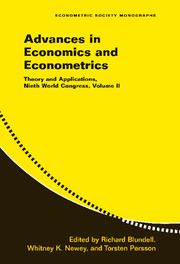Book contents
- Frontmatter
- Contents
- Contributors
- Introduction by the Editors
- Advances in Economics and Econometrics
- 1 Empirical Models of Auctions
- 2 Identification in Models of Oligopoly Entry
- 3 Empirical Models of Imperfect Competition: A Discussion
- 4 Recent Developments in the Economics of Price Discrimination
- 5 Bounded Rationality in Industrial Organization
- 6 Price Discrimination and Irrational Consumers: Discussion of Armstrong and Ellison
- 7 Behavioral Economics
- 8 Incentives and Self-Control
- 9 Discussion of “Behavioral Economics”
- 10 Dynamic Models for Policy Evaluation
- 11 Microeconometric Search-Matching Models and Matched Employer-Employee Data
- 12 Discussion of ‘Dynamic Models for Policy Evaluation’ and ‘Microeconometric Search-Matching Models and Matched Employer-Employee Data’
- 13 Field Experiments in Development Economics
- 14 Institutions and Development: A View from Below
- Index
- Titles in the series
11 - Microeconometric Search-Matching Models and Matched Employer-Employee Data
Published online by Cambridge University Press: 05 January 2013
- Frontmatter
- Contents
- Contributors
- Introduction by the Editors
- Advances in Economics and Econometrics
- 1 Empirical Models of Auctions
- 2 Identification in Models of Oligopoly Entry
- 3 Empirical Models of Imperfect Competition: A Discussion
- 4 Recent Developments in the Economics of Price Discrimination
- 5 Bounded Rationality in Industrial Organization
- 6 Price Discrimination and Irrational Consumers: Discussion of Armstrong and Ellison
- 7 Behavioral Economics
- 8 Incentives and Self-Control
- 9 Discussion of “Behavioral Economics”
- 10 Dynamic Models for Policy Evaluation
- 11 Microeconometric Search-Matching Models and Matched Employer-Employee Data
- 12 Discussion of ‘Dynamic Models for Policy Evaluation’ and ‘Microeconometric Search-Matching Models and Matched Employer-Employee Data’
- 13 Field Experiments in Development Economics
- 14 Institutions and Development: A View from Below
- Index
- Titles in the series
Summary
Abstract
The recent advent of matched employer-employee data as part of the labor market scholar's toolbox has allowed a great deal of progress in our understanding of individual labor earnings. A growing number of empirical analyses of available matched employer-employee data sets now combine with the already voluminous literature on empirical wage equations based on individual or household survey data to draw an even richer picture of wage dispersion, individual wage dynamics, and the productivity-wage relationship.
In this chapter we tour the empirical wage equations literature along these three lines and make a case that viewing it through the lens of structural job search models can help clarify and unify some of its recurring findings. Among other things, we emphasize and quantify the role of matching frictions in explaining the share of “residual” wage dispersion that is left unexplained by the reduced-form approach. Secondly, we quantitatively assess the importance of labor market competition between employers relative to non-competitive wage formation mechanisms (namely,wage bargaining) as a theoretical underpinning of the wage-productivity relationship. Thirdly, we show how search frictions, combined with a theoretically founded wage formation rule based on renegotiation by mutual consent, can account for the widely documented dynamic persistence of individual wages.We conclude with a list of questions that are open to further research.
INTRODUCTION
Understanding differences between individual wages – both across individuals (wage inequality) and over time (wage dynamics) – is a fundamental motivation of labor economics as a research field.
- Type
- Chapter
- Information
- Advances in Economics and EconometricsTheory and Applications, Ninth World Congress, pp. 279 - 310Publisher: Cambridge University PressPrint publication year: 2006
- 10
- Cited by



